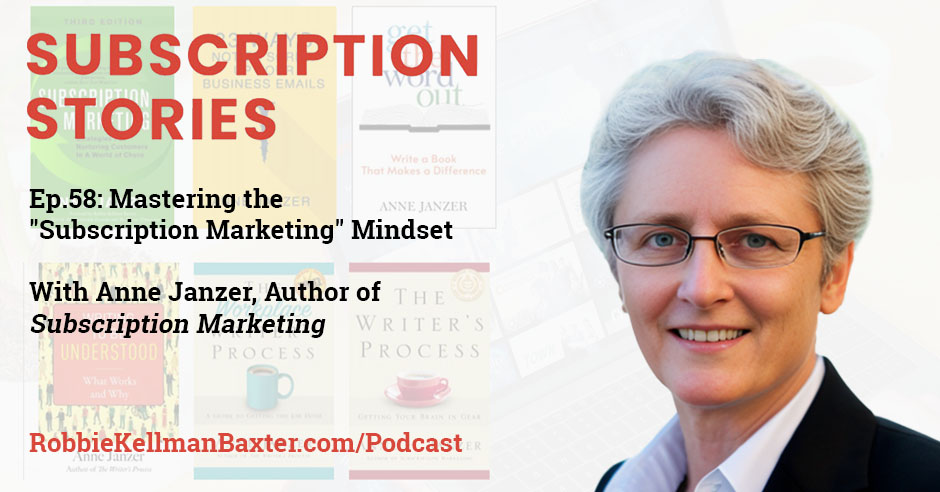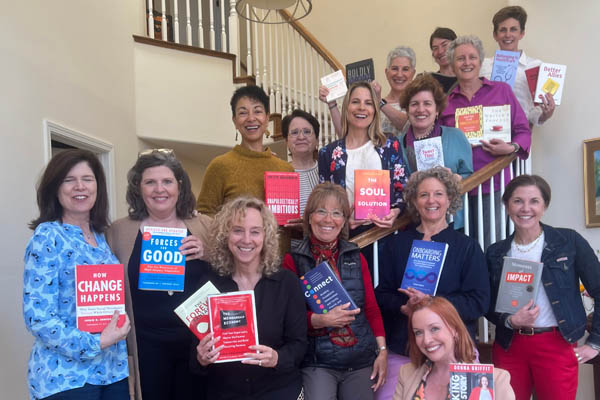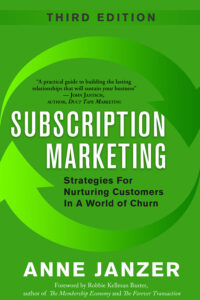
In the world of subscriptions, the role of a marketer is rapidly evolving. It’s not enough to acquire subscribers—you have to acquire the right subscribers. But how do you market with an eye toward retention? Today’s guest, Anne Janzer, is the author of Subscription Marketing, now in its third edition. In this episode, we focus on the right mindset for marketers and how to establish the right voice to connect with your subscribers. Anne also shares some clever ways to get the biggest return on your marketing spend, as well as who and how to hire for your subscription marketing team.
—
Listen to the podcast here
Mastering the “Subscription Marketing” Mindset with Anne Janzer
In the world of subscriptions, the role of a marketer is rapidly evolving. It’s not enough to acquire subscribers. You have to acquire the right subscribers, but how do you market with an eye toward retention? Our guest, Anne Janzer, is the author of Subscription Marketing, now in its third edition. In this episode, we focus on the right mindset for marketers and how to establish the right voice to connect with your subscribers. Anne also shares some clever ways to get the biggest return on your marketing spend as well as who and how to hire for your subscription marketing team.
—
Anne, welcome to the show.
Thanks for having me. I’m thrilled to be here.
I can’t believe I haven’t had you on before. I’m so excited to have you. I have a million questions for you.
We’ll have fun.
I wanted to start by talking about your book, Subscription Marketing. It’s in its third edition. Why have you updated it twice since its initial publishing in 2015?
There are two reasons for that. First, and you probably agree with me, the market has changed and matured since 2015. In 2015 when it first came out, I did spend a lot of time in the book explaining to people why the subscription model was relevant to them, even if they didn’t realize that it was or why. I honestly had people selling software through the Cloud saying, “Is this for newspapers and magazines? I didn’t know that was your market.” I was like, “This is you. This is for you.”
First was the understanding that the market has changed, and as things kept changing, I wanted to update. You could make an argument that we could talk about later that there should be a fourth edition post-pandemic on the lessons from that because things have certainly changed there. I’m not sure I’m going to write it, but there could be one.
The first time you updated it was?
2017. I updated it in part because things had updated but also because my own understanding had changed of the nuances of the market. Here’s a tip for anyone here who is thinking of writing a book. If you do it the backward way as I did, which is you research and write a book, and then you go out and talk to people about it, you’re going to deepen your expertise a lot not only in writing the book but afterward talking to people about it.
One of the things I found, which was so interesting to me, was that I was writing for the wrong audience. I learned that it’s really hard and well-nigh impossible to change some fundamental behavior in marketing organizations in established businesses. I ran into such headwinds there with the people I thought were my core readers who would say things like, “This is great. I love these ideas, but I’m incentivized on net new leads, so I’m never going to do this.”
I come from a background where the people who did marketing for your current customers, that was a backwater. You didn’t want to be put there. It was a career killer to be put in that part of the organization. I’m like, “What is wrong with marketing that we treat our own customers as toxic? What’s wrong with this?”
I did hear from entrepreneurs. I did hear from startups. I did hear from the growing subscription box industry. I heard from those larger companies that had been my clients back in the day, but I heard from the people in the customer success teams because they were the ones who were picking up the relationship after marketing had dropped it. Sometimes, they were even running a whole shadow marketing organization outside with their own CRMs, like siloed. I hope that’s not happening so much anymore.
I learned some nuances of how things were working that I didn’t have insight into when I first wrote the book. The second edition was much longer. The third included more split-outs for how you could do this if you’re a solopreneur, what are the things to take from that, and what are the things to take if you’re a rapid growth startup. I added some other things I’d also learned about the different audiences for the book.
It’s so interesting. I had very similar experiences. Our first books came out around the same time, 2015. For me, I wrote The Membership Economy as a one-pound business card to say, “This is what I see. This is what I believe. If it makes sense to you, let’s work together or I can consult to you.” If you are saying the things that you were describing that people say to you, I’d probably be like, “Let’s not even waste our time.” If you tell me that the person I should be dealing with is all the way in the backwater of the marketing department, very junior with little power, we’re not going to make any change happen.
You’re right. In book two, you needed to be talking more to the startups and more to the de novo subscription businesses. Now, I don’t know what you think, but I’m seeing a lot of big companies being told from the top, “We need to get into subscriptions.” Suddenly, there’s an appetite for, “How does this affect the whole organization?”
You were always speaking at that much higher level. You’ve maybe been speaking at the right level to make this message across. I was coming in too low. It is encouraging to see. It’s still not as widespread as I would’ve thought it was going to be. I still see a lot of the old mindset, and we can talk about that, and how that underscores or undermines our vision and strategies for subscriptions, membership, and ongoing relationships.
A question I have for you and something I’ve been grappling with is, in a subscription business, where does the role of marketing stop? Is it I’m responsible for identifying the target audience and reaching out to them, but once they sign up, it’s not my problem anymore, or does their role continue post-sale?
I think the role should continue, but our silos or our barriers have to be permeable in the organization. That’s the real trick to it. It is building in that cross-organization permeability. There can be a handoff to customer success, but it ought to be seamless, planned, orchestrated, and part of what the subscriber perceives as a consistent relationship. From the subscriber’s perspective, they have a relationship with one organization, not 5 five departments. That’s what it should be.

Subscription Marketing: Anne (Top of stairs, purple blouse) and Robbie (front row with black blouse) at a Meetup of the Authoress group, hosted by Robbie in 2023.
That’s how it should feel. It should feel like one journey.
Exactly.
It’s interesting because you’re a writer’s writer. In addition to your book on Subscription Marketing, you’ve written a lot of books on the writing process. You have a new book coming out about writerly voice. One of the things that I think about is, in a B2B subscription business, SaaS, or any kind of as-a-service business, do you need marketing and customer success, which customer success being the post-sale relationship organization? Is that a marketer, or is that a good communicator? The roles are changing.
Fundamentally, there are things in the marketer’s toolkit that are helpful in customer success. They’re helpful in sales. There are marketing strategies and tactics. Marketing is how you do some of these relationships at scale. That should be how it happens. Communication is an overarching skill and one that’s critical to maintaining successful relationships with your customers. It’s certainly something that can’t belong exclusively to the marketing organization.
Communication is an overarching skill that’s critical to maintaining successful relationships with your customers. It’s certainly something that can’t belong exclusively to the marketing organization. - @AnneJanzer Share on X
In terms of creating that fundamental relationship story and the story that you have of how you engage with your customers, that’s something that might originate in the marketing organization, but it needs to have buy-in from the entire organization. We all need to be able to inhabit and participate in that story.
It’s everybody reading from the same sheet of music. In some cases, especially on the consumer side or when the price is low, anybody in the post-sales part of the business probably isn’t communicating orally or verbally. They’re probably writing it down, so you get back into whether you can communicate and continue to sell. I believe you have to be able to continue marketing your offering after a transaction because now you’re saying, “You bought it but you can cancel at any time. Here are some reasons and ways you can continue to use it to get the value that you’re entitled to so that you don’t cancel.”
That’s right. That’s the gist of why we care. I tried to give marketers another term or another thing to think about, which is we’re already focused on lead generation and lead nurturing. If you are in marketing, you understand what those activities are. I tried to introduce a third one, which is called value nurturing. It is consistently nurturing the experience of value once someone has signed up. I tried to say, “This belongs to marketing, too, or not. You can seed it to someone else.”
The longer a subscription-based business is in business and the more successful it is, the more of your revenues are going to come from your current customers. If marketing wants to be relevant, they should be affecting those revenues and not just the net new revenues. Show me the money. Be where you have the largest leverage on the income and the revenue of the business.
Value nurturing, I love that term. It is about the marketer’s role after the point of sale to continue to deepen the value achieved on both sides.
It doesn’t just belong to marketing. Value nurturing belongs to everybody. It belongs to everyone who has any interaction, even fulfillment. Certainly, the customer success team and support are all trying to nurture that sense of value to make people think that they’ve made a good decision and they’re achieving value from their decision to renew.
It’s a very different mindset. You talk about mindset for marketers as being as important as tactics. Why is it so important? What is the right mindset for a subscription marketer or somebody that’s involved in value nurturing post-sale?

Anne Janzer’s newest book: The Writer’s Voice
To answer this, I’m going to ask you first to flip and think about, as a consumer, the difference between simply buying something like, “I’m going to go buy a new pen,” and subscribing to something like, “I’m going to subscribe to a new pen every month.” These feel different to me. I suspect they do, too, for you. One is a quick, “Is this pen good enough? It will meet my needs. I’m done.” Another is this ongoing relationship.
As marketers, we need to take into account the fact that it’s a different kind of decision. We need to do more than say, “Look at my features.” We have to say, “This is what it’s going to be like to be in this long-term relationship with us.” We have to say, “This is a relationship. You can trust us. We’ll trust you.” It’s a different thing.
Beyond saying a one-time exchange of value for money, we are not a transactional or relational thing. We’re getting into a relationship and we need to say, “This is valuable. It will continue to be valuable. You can trust us. We’ll work together and have a relationship.” It’s a fundamentally different thing. In your subscriber’s head. Ergo, you have to think carefully about your marketing tactics, strategies, and what you do to support that. You have to think differently about how to sell.
It’s interesting. I remember very early in my career, I was doing marketing at a tech company. I remember we had a PIG, a Product Information Guide. It was what you gave to somebody when they bought this enterprise solution that told them, “Here are all the features, and here’s how they work.” If you put that product information guide side by side with anything else that marketing did, it was like night and day because it was so poorly written. It had no illustrations.
There was no selling in it. There was no, “I want to make sure that the customer is using these awesome features that we spent all this time building.” The reason was once they drive the Lamborghini off the showroom floor, they’re like, “It’s not my problem.” Now, we see how much more important customer experience is and how user experience design is so much more important. It is a different mindset. It does affect not just marketing but every part of the organization because the customer can leave. That’s why. The customer still has a choice every day.
This is a different way of thinking about marketing. You’re not chasing the net new sale. Although too many people are still chasing the net new sale, you shouldn’t be. You should be looking at the long-term relationship. You know this. You can lose money chasing and acquiring the wrong customers. A net new sale is not necessarily always the right thing if it’s not the right customer.
Especially a lot of subscription companies are thinking about this. Budgets are tight. I can’t tell you how many clients have told me in the last couple of months, “It’s not enough anymore for me to prove that I can acquire customers or even keep them. I have to prove that they’re profitable.” It’s about this customer’s lifetime value as a multiple of the cost of acquisition. It’s a very different experience. Somebody told me this, and I don’t know if it’s true or not. She said, “You have to be over 40 to have had a P&L the last time the economy was down.”
That’s interesting.
If the average people joined the workforce, let’s say, in their early twenties, that means that there are a lot of people out there who have never seen a down economy and have not had to be so focused, breakeven, on profitability and making your little business off in the corner of the large company pay for itself. If you’re in a startup situation, there’s less about going for the gusto and more about paying your own way. I’m wondering. What advice do you have for subscription marketers if they do find these new pressures or find that their budgets are shrinking and their goals are staying the same?
We’ve already touched on one, which is to think carefully about the customers that you are attracting and that you want to attract. There is the old adage about how much easier it is to keep a current customer than acquire a new one. Invest in these relationships. Investing in relationships during difficult times gives you a nice base for growth when things do improve.
There’s room for non-budget-sensitive activities. When you’re talking about relationships, it’s not just about the most advertising spent. That has nothing to do with relationships. Relationships can take place in a delightful email that you get when you order something and it’s been shipped. The email that you get from the people makes you laugh and get some perspective on the company. Relationships can be fostered when you have a shared set of values with your customers. It is when you understand your customer’s story and say, “We believe in rescuing dogs, so all of our profits go to that,” and the customer says, “I want to be a customer.”
Sometimes, the things that have the biggest impact on your customer relationship are not things that are budget intensive. It’s something to think about creatively all the ways that you can nurture that relationship. That doesn’t have to do necessarily with spending huge marketing budgets, but it does have to do with thinking carefully about your customers who are best served by your solution. It is your best customers, those who are going to have the most lasting success with you because they will stick around. It’s the harder work of showing up in a relationship rather than spending money.
Nurturing customer relationship doesn’t necessarily mean you have to spend huge marketing budgets. It does have to do with thinking carefully about your customers who are best served by your solution. - @AnneJanzer Share on X
It’s less about dating and more about being committed. To summarize, you said in the time of a budget crunch, number one, get even more focused on who your best customer is or your best subscriber and use your limited ad spend or marketing spend on people that fit that profile. The second thing that you said is to find other ways to nurture the relationship even through emails with humor and whimsy but thinking about post-sale interactions with existing subscribers. It sounds like it’s good discipline for any business to spend a little time on this stuff. It’s not that anybody is wishing to have smaller budgets, but it does force you to use some muscles that you haven’t been leaning on.
As long as you can be checking all the boxes and doing all the things, perhaps you’ve been scattering your efforts and not getting the most out of your investment. Marketers, in particular, are prone to the shiny object syndrome. It’s like, “Let’s build a whole TikTok thing.” Whatever the thing may be, we were suckers for it. To make yourself a little bit more disciplined is useful, especially when you do it in service of a lasting relationship with your customer.
Another thing I would suggest is to find ways to open that are not one-way channels to your customer but you’re hearing back and working with them when things are tough, which is going to be more important to you, A or B. Use some insight to have people feel like you’re in this relationship together as opposed to the unilateral decision on things. You keep people posted. If prices have to go up, be honest about what that is. Talk about maybe what value you might be able to add. Make sure you’re looking at how they perceive the value they have of being a subscriber in that situation. Have those hard conversations honestly. You’ll lose people, but you won’t lose people in a huff.
I love that. You can lose people, but you don’t want to lose them in a huff.
If you lose them in a huff, they won’t come back and they won’t say anything good. If you lose them because they’re like, “I can’t handle this budget,” they can come back when they can.
I like that you also point out the market research element of subscriptions. I’ve heard it called, especially when there’s a physical product involved, revenue-generating market research. It’s that subscriptions are a form of revenue-generating market research.
That’s brilliant.
You do have permission to ask for feedback. You do, in many cases, see the actual behavior. You see when they logged in, whether they upgrade or downgrade, and all of that. That allows you to invest more thoughtfully in the future of the business.
We can look back a few years early on in the pandemic. There were subscriptions for restaurants that were helping them with reservations. Those who said, “We’re in this together. How can we help you through this thing?” are the ones that did well. There were those that said, “You could wash your hands and give up.” You could say, “How can we work together to create something that’s going to meet your needs? It’s going to be messy because we’re doing this on the fly,” but that’s okay because you’ve got some feedback in it.
We saw in those days a lot of creative responses to situations that were not planned. The companies that seemed to do well were those that treated their customers not as a resource for more money but as the longer-term part of their business and how it is going to grow through that. There are lessons to be learned there too.
It was that “We’re in this together.” The word membership, whether you use it or not, reminds especially companies and employees, “These are people who are going to be around for a long time. We need to treat them as if we’re going to see them in the future.” Back to your point on mindset, that becomes important and valuable when something dramatically changes like what happened in the pandemic.
That’s when we talk about mindset. The fundamental thing is to change from this transactional to this longer-term relationship, “What if this person was here next to me? How would they feel about what I was doing?”
If you were helping to hire people for the marketing organization in a subscription business, assuming that they have the usual credentials, what are you looking for? How do you know if they have the right mindset to be effective?
Especially in the early stage of a business, I would look for someone who was not afraid to question established practices in the industry. We need to get out of the way that marketing has always been done and be more creative and look at, “That’s what they do over there in retail. That’s what they do over there in something else.” It is creativity in that sense of questioning those practices.
Secondly, and maybe even more important especially as the business goes, it’s a certain courage of your convictions then to resist the constant pull of the quick short-term win that damages the relationship. Resisting the constant pull of the shiny new thing that takes your eye off the ball of what it is., who you are serving, and why. We need to question assumptions but don’t question principles. It takes a certain kind of steadfastness and courage. I say courage because the world is always pulling us to the quick win that may not be something that serves us well in the long-term.
That’s especially attempting now when people are scared. They’re seeing budgets pulled back on their products and saying, “How do we hit our numbers?” As you pointed out, quarterly capitalism is a very real phenomenon of people saying, “We got to hit this number for our shareholders or, honestly, for my bonus.” I’ve worked with my share of companies where leadership shot down a very sound subscription argument because they had to hit a number this quarter to get their bonus.
Back to your earlier points about how hard it was to convince large companies to change their behavior, if compensation is based on acquisition, they’d be stupid to spend time on retention because they’re not going to be rewarded for it. That becomes an important element to understand what the incentives are not just at the level of the team but at the level of leadership or even the level of the ownership of the company.
That’s right. This discussion has to filter all the way to the top. It has to filter up there, or else, you’re going to be fighting a really hard battle.
I always say to people who are looking for jobs in subscriptions, “Make sure that the CEO says that subscription is a top three priority, or don’t go work there because you’ll never be able to move that mountain.”
That’s very good. That’s great advice.
A lot of people come in with a lot of optimism that they can change the whole organization. It’s hard to do that from the middle.
Once again, the relationship analogy comes into play.
They’re not going to change. If they didn’t do it when they were recording, they’re not going to do it now when things are finalized. I want to change gears a little bit to talk about freemium and free trials. The role of free in subscription businesses is a much-discussed topic. Where do you come down on when and how much organizations should give stuff away?
This is a delicate dance with that are-you-attracting-the-right-person discussion. We need to look at that first and where you are. If you were brand-new out of the gate and you needed people to see how the thing works and you needed them to see the experience to understand it, there’s a reasonable argument to say, “Try everything for free.”
The free trial versus the free and premium level are two different discussions. If there’s a network effect in your software, then the free and premium makes a lot of sense. The one caution I have with that is to make sure that if you’re going for the free and premium that your finances are going to work if it scale a lot. At that moment when you have to say, “We can’t offer this free anymore. We’re going to gut this one and go for it,” you’re taking something away from people. We have this loss aversion. We get upset when things are taken away from us, so that will be a harder thing to ride through that transition.
If your business is going for free trials and freemium offers, make sure your finances are going to work it they scale a lot. - @AnneJanzer Share on X
If you’re offering a free with a premium, make sure the free one is not a brain-dead version of the premium but genuinely has some value in itself. You will then be able to continue offering it or have to bite the much more painful process of taking something away from it. The free trial is often a good idea because if a subscription is built on both trust and value, it’s an opportunity for you to say, “We’re going to trust you to use it free for a month. Try it out and see what the experience is.” The free trial makes a lot of sense, especially for fairly complex situations.
I’m embarking on a free trial of an email program, and I’m delighted by all the training that’s available to me. I can call and get support. I get to see what it’s going to be like to be a customer. That’s a really nice thing from my perspective as I up my investment in this software that I feel good about and the vendor I’m with. I would think about that as a chance for the potential subscriber to experience what it’s like to be an actual subscriber. It’s not just how to use the software but to be in a relationship with the company. You need to bring your best game to support those free trial users.

Subscription Marketing: You need to bring your best game to support those free trial users.
What I hear you say is, number one, know that you have an ROI on your free offering so that it will scale with you. Look for opportunities to try it because a free trial can certainly be valuable as a way of building trust. Freemium can be effective as part of a bigger business model, but you better know what part it’s playing in that bigger business model or network effect.
How does the premium play? Of the people who take the free one, what percentage of them have to be premium for it to make sense? Are you going to reach them? It works very well with some solutions and less well with others. That’s tricky. I didn’t solve the problem.
The thing that I often say to people is, “Consider it free but don’t always do it. You should always consider it. It is a tool. It can be powerful, but make sure that you understand what it’s being used for.” What you point out that’s so true is anything that you do in a subscription is based on trust and consistency. Once you give something away, it is very hard to take it back, so be careful. That makes sense.
It is very hard. We’ve seen businesses that have started out this way and then had to, “We’re going to gut this and make everybody move to the free thing.” It may financially work, but they do lose a lot of customers at that time. Their competitors pick up a lot of customers and say, “MailChimp raised their rates. Come on over.” You’re heading for some choppy waters when you do that.
It makes customers reconsider their decision in the first place.
You’re throwing it all open again. That’s so true.
Here’s something else that’s controversial. What is your perspective on hiding the cancel button? I know you’re going to say it’s bad because it is bad, but more and more, especially in this time of difficult budgets, recession, and people pulling in, I’m hearing again this murmur of, “It’s not the nicest thing in the world to do, but it does work.” Where do you come down to hiding the cancel button and adding two screens or two clicks to get out? There are people that are like, “You can sign up online, but if you want to cancel, you got to call us on Tuesdays between 4:00 and 4:15.” What do you think?
You’re making my skin crawl. First, check the laws. There are some laws, at least in California, about that, so make sure that you are on the right side of the law on that. Here’s what I have to say. Short-term, this may be more profitable. When I was talking about having the courage to resist things, this is one of the issues. If you are basing your business’ success on your customers being too distracted, lazy, pressed for time, or stupid to unsubscribe, that’s a dangerous long-term game. I’ll tell you why. It’s because we live in an age of radical transparency. Eventually, your customers are going to figure it out. They’re going to talk to others about it. It’s going to work against you.
If you are basing your business success on your customers being too distracted, lazy, or stupid to unsubscribe, that’s a really dangerous long-term game, especially in this age of radical transparency. - @AnneJanzer Share on X
You have to assume that your customer’s sitting right there next to you at your desk saying, “Would you want those meeting notes published to the world? Let’s make sure it’s hard to unsubscribe. We’ll squeeze an extra two months of subscriptions out of everybody.” It’s more to the point. The numbers person says, “It’s making us money.” I would say yes, but if that’s the decision your business is making, you’re going to profit off your customers working against their best interests. “I want to profit off of them making mistakes.” That’s what you’re saying. I wouldn’t want to be involved with that company as a customer, and I wouldn’t want to be involved with that company as an employee.
Bad deal, bad karma.
If that’s the decision you want to make and hope all your employees feel engaged with working for you, go for it, but they might also be able to find a company that’s more aligned with their values. I don’t know. It’s bad karma. People will do it, but more people are onto it, too. As consumers, we see it and feel it. It’s like, “Ugh.” We sign up for these services that help us find and get rid of those hidden subscriptions. Every time you do it, you’re poisoning the well for businesses that don’t. It’s not the right thing to do.
It will haunt you in the long-term. I agree. Do you have time for a speed round?
Yes, I do.
What was the first subscription you ever had?
It was probably the Ranger Rick magazine when I was a kid.
What is your favorite subscription as a writer?
I have so many. I can’t even tell you. I don’t even know where to begin. I’m having a lot of fun. It’s not my favorite as a writer, but it is fun as a brainstorming buddy with ChatGPT. I’ll tell you that.
That’s a good one. What is the subscription marketing campaign? You can have a few.
I love the things that don’t look at all like marketing campaigns. I love things like Fender giving away more online free guitar classes during the pandemic. I love those kinds of generous things. They don’t look like marketing campaigns, but they are serving the function of giving value out in the world. I love things like that.
They’re relationship-building campaigns that trust in the long-term.
Long-term plays are the ones that impress me.
What are you reading now?
I’m reading Annie Duke’s book, Quit. It is about when to know to stop doing something. It’s very interesting. I enjoy her work a lot.
I’ll have to put that on my list. I haven’t read that. This is great. We could keep talking for a long time. I did not get to all the questions that I had, but I love talking to you. Thank you so much for all that you’ve done for the world of subscriptions, and thank you for being a guest on the show.
Thanks for having me. It’s always fun to talk with you. We are so aligned.
—
That was Anne Janzer, author of Subscription Marketing. She has a new book coming out, The Writer’s Voice, to help us all become better communicators even if we aren’t marketers. For more about Anne and her work, go to AnneJanzer.com. For more about subscription stories, go to RobbieKellmanBaxter.com/podcast. Also, I have a favor to ask. If you like what you read, please take a minute to go over to Apple Podcasts or Apple iTunes, and leave a review. Mention Anne in this episode if you especially enjoyed it. Reviews are how people find our show, and we appreciate each one. Thanks for your support and thanks for reading.
Important Links
- Anne Janzer, Nonfiction Book Coach, Developmental Editor, Cuesta Park Consulting
- Subscription Marketing
- The Membership Economy
- The Writer’s Process
- Anne Janzer’s Website
- The Writer’s Voice
About Anne Janzer
 Anne Janzer is an award-winning author, armchair cognitive science geek, nonfiction author coach, marketing practitioner, and blogger. She’s on a mission to help people spread important ideas through writing.
Anne Janzer is an award-winning author, armchair cognitive science geek, nonfiction author coach, marketing practitioner, and blogger. She’s on a mission to help people spread important ideas through writing.
As a professional writer, she has worked with more than one hundred technology companies, writing in the voice of countless brands and corporate executives. She is author of the books Get the Word Out, Writing to Be Understood, The Writer’s Process, The Workplace Writer’s Process, and Subscription Marketing.
Her books have won numerous awards, including the Independent Book Publishers IPPY award, the Foreword Indies Book of the Year, Reader’s Favorite Gold Medal, and the IndieReader Discovery Award. They have been translated into Japanese, Korean, and Russian language editions.
Anne also regularly speaks or hosts online webinars for writing conferences, writer’s groups, and corporate marketing teams and writing groups.
Love the show? Subscribe, rate, review, and share!
Join the Subscription Stories Community today:




